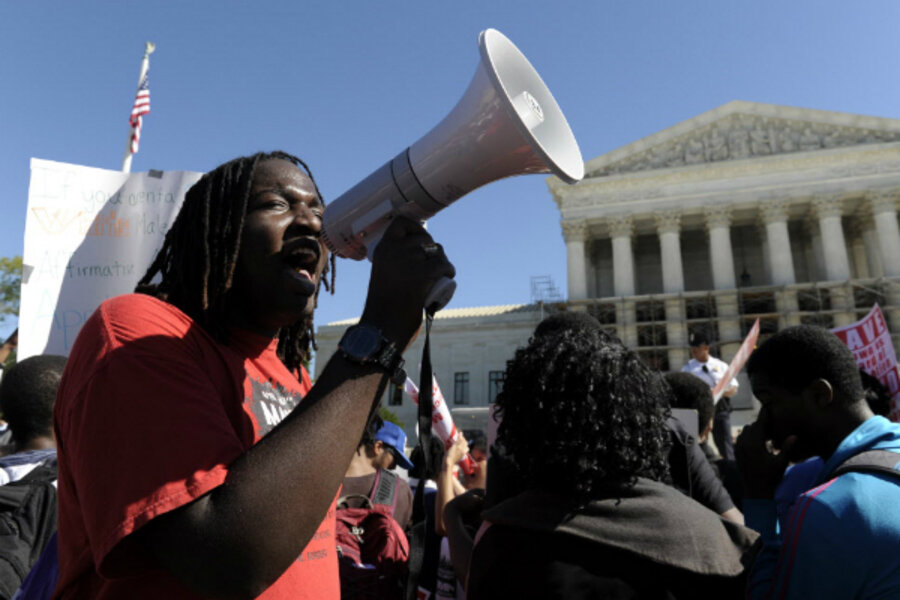Supreme Court hints at narrow ruling in Michigan affirmative action case
Loading...
| WASHINGTON
The US Supreme Court took up an unusual – but important – civil rights case on Tuesday testing whether a ban on using race-based affirmative action in college admissions in Michigan violates the equal protection rights of minorities.
The case arrives at the high court four months after the justices declined to issue a sweeping decision in a case testing the constitutionality of an affirmative action program at the University of Texas.
Based on questions asked during the hour-long argument session on Tuesday, it appears that the justices are disinclined to issue a broad ruling in the Michigan case, as well.
Instead, several conservative justices seemed to be searching for a way to uphold Michigan’s ban on affirmative action without overruling underlying precedents.
The court’s liberal justices were unified in their opposition to the ban.
The case is being heard by eight of the nine justices. Justice Elena Kagan has recused herself, because she worked on the case while serving as US solicitor general.
That leaves a potential 5-to-3 lineup if the court splits into conservative-liberal camps.
The case, Schuette v. Coalition to Defend Affirmative Action (12-682), involves a legal challenge to a 2006 statewide ballot initiative in Michigan. The measure, Proposition 2, amended the state constitution to ban race-based affirmative action in public education. Fifty-eight percent of voters approved it.
In urging the justices to uphold the ban, Michigan Solicitor General John Bursch argued that there is a significant difference between removing an anti-discrimination law from the books in a way that hurts minorities and enacting an equal treatment law that merely requires that everyone be treated the same.
“It does not violate equal protection to require equal treatment,” Mr. Bursch said.
Justices Ruth Bader Ginsburg and Sonia Sotomayor questioned whether the Michigan ban had been passed in part out of racial animus – a desire to harm the admission prospects of minority students.
“One of the main sponsors of this bill said it was intended to segregate again,” Justice Sotomayor said.
Solicitor General Bursch responded that a federal judge had found there was no proof of improper motive behind the ban. He said the lack of racial animus was a reason to uphold the measure.
Justices Ginsburg and Sotomayor continued to press Bursch on the impact of the ban. They noted that it had resulted in a significant decrease in minority enrollment at the University of Michigan.
Bursch responded that enrollment statistics weren’t as bad as reported. He said some of the decrease could be attributed to a change in the way the university asked new students to identify themselves on enrollment forms in terms of race and ethnicity.
Mark Rosenbaum, a Los Angeles lawyer representing opponents of the ban, told the justices that organizers of the Michigan ballot initiative bypassed the proper channels to address the affirmative action issue.
He said the measure violated the high court’s “political restructuring doctrine,” an approach based on two Supreme Court equal protection precedents handed down in 1969 and 1982.
The doctrine holds that under the 14th Amendment’s Equal Protection Clause the government may not enact changes to the political process that will make it harder for minorities to exercise their rights.
Michigan law assigns to the Board of Regents at each university the authority to enact or repeal affirmative action programs. Rather than lobbying the boards to reverse their race-based policies, opponents of affirmative action went above the boards and directly to the people to amend the state constitution to forbid any race-conscious preferential treatment in college admissions.
Mr. Rosenbaum argued that by amending the state constitution via a statewide vote, the usual political process (involving the Board of Regents) had been substantially altered in a way that undercut the ability of minority groups to lobby state officials to adopt affirmative action plans. That, he said, violated their constitutional rights.
Rosenbaum told the justices that Michigan would have to reassign the power over affirmative action programs away from the regents prior to passing any statewide ban.
Because the affirmative action initiative deals with race, he added, it implicates the equal protection requirements of the 14th Amendment.
“The people of the state have multiple options available to them if they don’t like the way the universities are operating,” Rosenbaum said. “But the one option they don’t have is to treat racial matters different from all other matters.”
The lawyer said the constitutional ban on affirmative action established a “separate and unequal” track for deciding the affirmative action debate, a political process minorities could not make equal and effective use of.
“You have to use the ordinary political process. And that’s all we’re saying,” Rosenbaum added.
Michigan is no stranger to controversy over affirmative action. More than a decade ago, white students challenged race-conscious admissions programs at the University of Michigan and the University of Michigan Law School. In 2003, the Supreme Court struck down the university’s affirmative action program for relying too heavily on race. At the same time the high court upheld the law school’s program.
The majority justices said the law school’s admission plan was sufficiently holistic to avoid making an applicant’s race a determining factor in who was admitted and who was rejected.
Three years later, state voters enacted the constitutional ban on affirmative action.
The ban sparked litigation. A federal judge upheld the ban. An appeals court panel voted 2 to 1 to strike it down, and the full Sixth US Circuit Court of Appeals invalidated the ban in an 8-to-7 decision.
It is that decision that is now before the Supreme Court.





